|
|
|
Sort Order |
|
|
|
Items / Page
|
|
|
|
|
|
|
| Srl | Item |
| 1 |
ID:
128890
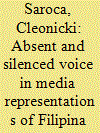

|
|
|
|
|
| Publication |
2013.
|
| Summary/Abstract |
This article explores the absent and silenced voice in Australian newspapers through case studies of two Filipino women - Nenita Westhof and Marylou Orton - who were victims of homicide in Australia. It draws on a feminist discourse analysis of newspaper articles and interviews conducted with their families and friends. The method used is one way of enabling people to hear the stories of those who do not have a voice in the present. Analysing newspaper representations in light of the interviews provides an entirely different, more accurate and just reconstruction of the women's lives. Media representations of Nenita and Marylou bore little resemblance to their 'lived reality'. In most instances, journalists did not acknowledge that the women were victims of domestic violence. Furthermore, sexist, racist and class-based discourses constructed Nenita and Marylou in accordance with dominant representations of Filipino women in Australia. They were held accountable for their own deaths, while their abusive male partners were frequently portrayed as victims of women who abused them. The article argues that such representations sensationalize the issues, misrepresent violence as the women's fault and shift responsibility from the perpetrator to the victim. In the process, they silence women's voices.
|
|
|
|
|
|
|
|
|
|
|
|
|
|
|
|
| 2 |
ID:
078838


|
|
|
|
|
| Publication |
2007.
|
| Summary/Abstract |
This paper addresses a puzzle of how conflicts characterized by significant power asymmetries often play out much differently than dominant powers expect. We adapt the notions of institutionalized peace and riot systems from the literature on ethnic violence to identify ways in which social institutions attenuate collective action dilemmas, thereby increasing capability for a less-powerful group. Dominant groups often miscalculate the true nature of capability relationships by failing to account for these group-specific institutions that operate in the face of exogenous threats. We illustrate our model with two episodes of Chechen mobilization in the 1990s
|
|
|
|
|
|
|
|
|
|
|
|
|
|
|
|
| 3 |
ID:
133594
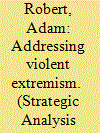

|
|
|
|
|
| Publication |
2014.
|
| Summary/Abstract |
In the years since the hostilities in Sri Lanka ended in 2009, the understandable international focus on the evidence of war crimes by both sides has diverted attention from certain other questions that emerge from the 26-year conflict between the Liberation Tigers of Tamil Eelam (LTTE) and the Sri Lankan government. Here I briefly explore three general questions that have arisen not only in Sri Lanka but also in many other modern conflicts, including those characterised by what is variously called asymmetric warfare, violent extremism or terrorism.
|
|
|
|
|
|
|
|
|
|
|
|
|
|
|
|
| 4 |
ID:
053810


|
|
|
| 5 |
ID:
125075
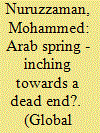

|
|
|
|
|
| Publication |
2013.
|
| Summary/Abstract |
A high degree of pessimism continues to hold a strong grip over the enthusiasts of democracy in the Arab world. In the last more than two years, the popular uprisings for social and political change have stalled in Bahrain, Syria, and Yemen. In Egypt, Libya, and Tunisia, where the populace succeeded in toppling the authoritarian rulers, the situation did not change that much. Violence, conflicts, and killings of political opponents disturbingly characterize all the Arab countries affected by the popular uprisings. In Syria, the government and opposition forces are locked in a deadly conflict with neither side being able to make a decisive breakthrough. The Egyptian army overthrew the country's first democratically elected government, headed by the Muslim Brotherhood, on 3 July 2013. On the whole, the success rate of democratization is so far disappointing. That begs the question whether the Arab popular uprisings for democratic change, what the media has conveniently dubbed the 'Arab Spring', are failing or still enduring.
|
|
|
|
|
|
|
|
|
|
|
|
|
|
|
|
| 6 |
ID:
130405
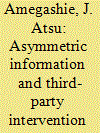

|
|
|
|
|
| Publication |
2014.
|
| Summary/Abstract |
I study a two-period model of conflict with two combatants and a third party who is an ally of one of the combatants. The third party is fully informed about the type of her ally but not about the type of her ally's enemy. In a signaling game, I find that if the third party is unable to give a sufficiently high assistance to her ally, then there exists a unique separating equilibrium in which the third party's expected intervention causes her ally's enemy to exert more effort than in the absence of third-party intervention; this worsens the conflict.
|
|
|
|
|
|
|
|
|
|
|
|
|
|
|
|
| 7 |
ID:
131907
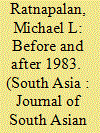

|
|
|
|
|
| Publication |
2014.
|
| Summary/Abstract |
This paper discusses the material effects of the theorisation of the contemporary Sri Lankan Tamil diaspora around the 1983 Colombo riots. In the complicated aftermath of the end of the Sri Lankan civil war in 2009, it is necessary to rethink the way in which diasporic history has been constructed in order to factor in its multiple dimensions and underlying dynamics. By critically foregrounding the key literature on the Sri Lankan Tamil diaspora, which is definitive to understanding the history of Sri Lankan Tamil emigration around the 1983 riots, the modern diaspora can be framed anew by longer and more diverse historical perspectives.
|
|
|
|
|
|
|
|
|
|
|
|
|
|
|
|
| 8 |
ID:
124882
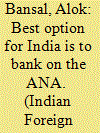

|
|
|
|
|
| Publication |
2013.
|
| Summary/Abstract |
Many analysts perceive that India should evolve a joint strategy with the Central Asian States to counter both the Taliban and Pakistani influence in Kabul. However, this has the grave disadvantage of being perceived as anti-Pakhtoon in Afghanistan's fractured ethnic mosaic. Similarly, any coalition with Iran is likely to be perceived as anti-Sunni by the dominant sect in Afghanistan. In addition, considering the current state of US-Iran relations, any relationship with Iran has a risk of running afoul of the USA. The best option for India is to bank on the ANA and pro-India politicians in Afghanistan. India must not allow it to be side-lined on Afghanistan as was done in the Turkey and London Conferences. There are many Afghan politicians who are willing to do India's bidding.
|
|
|
|
|
|
|
|
|
|
|
|
|
|
|
|
| 9 |
ID:
162776
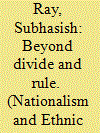

|
|
|
|
|
| Summary/Abstract |
Existing cross-national research on inter-communal violence has demonstrated that ex-British colonies are more prone to inter-communal violence than ex-colonies of other European powers. This finding has been attributed to the greater prevalence of divide-and-rule policies in ex-British colonies. This explanation is, however, incomplete since it implicitly assumes that British imperial policy profoundly transformed pre-colonial political realities. This article argues, instead, that the impact of British divide and rule strategies on subsequent inter-communal violence is crucially contingent on the level of political centralization attained by communal groups in the pre-colonial era. Drawing on a novel dataset tracking ethnic group dyads in 21 ex-British colonies across the period 1940-2006, I provide robust evidence indicating that the pathway from the experience of British colonial rule to contemporary inter-communal violence is more complex than hitherto appreciated.
|
|
|
|
|
|
|
|
|
|
|
|
|
|
|
|
| 10 |
ID:
124983
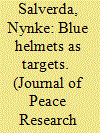

|
|
|
|
|
| Publication |
2013.
|
| Summary/Abstract |
A majority of UN peacekeeping operations deployed to civil wars face violent attacks by rebel groups. To date, the academic study of this type of violence has been very limited. This article is a first attempt to fill this gap. In particular, I aim to examine why rebel groups fight against peacekeepers in some cases, while not in others. I argue that since peacekeepers are mostly impartial but not neutral, they become an actor in a conflict and tend to protect the weaker side from total defeat. This implies that on the one hand, relatively weaker rebels will seek protection from the government by peacekeepers. On the other hand, relatively stronger rebels will challenge the peacekeepers in order to restrict their behavior and/or make them withdraw. If stronger rebels are successful in targeting the peacekeepers and the peacekeepers withdraw or alter their behavior, a victory for these rebel groups should become easier. Using novel data on violence against UN peacekeepers, I find that indeed, stronger rebel groups are more likely to fight against peacekeepers.
|
|
|
|
|
|
|
|
|
|
|
|
|
|
|
|
| 11 |
ID:
133220


|
|
|
|
|
| Publication |
2014.
|
| Summary/Abstract |
THE RECENT LITERATURE ON CIVIL WARS IS WIDE and deep; a number of major studies compel us to rethink what we know about this important subject. One of the areas that has eluded concerted scholarly attention has been the question of how national armies can be developed that satisfy the imperatives of post-civil war reconciliation and democratic consolidation. This issue is at the center of this article.
Civil wars are fought for different reasons in very different settings and are resolved differently. Nevertheless, it is possible to draw valuable lessons of building national armies from even highly disparate attempts in very different post-civil war environments. The principal goal of this article is to highlight, through their contrasting achievements and shortcomings, lessons we can learn from three cases.
|
|
|
|
|
|
|
|
|
|
|
|
|
|
|
|
| 12 |
ID:
127616
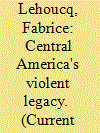

|
|
|
|
|
| Publication |
2014.
|
| Summary/Abstract |
Armed conflict liquidated Central America's dictatorships by the end of the twentieth century. Only Costa Rica was democratic when a wave of civil wars broke out in the 1970s; by the mid-1990s, every country on the isthmus had replaced dictators or military juntas with elected presidents and legislators. Every nation in the region now allows adults at least 18 years old (or 16, in Nicaragua) to cast ballots in regularly scheduled elections
|
|
|
|
|
|
|
|
|
|
|
|
|
|
|
|
| 13 |
ID:
127334
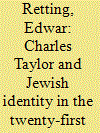

|
|
|
|
|
| Publication |
2013.
|
| Summary/Abstract |
The Jewish world is losing its ability to discuss its cultural differences. Our intra-Jewish dialogue is becoming less coherent. Indeed, the very ideas underlying our Jewish identities, ideas shaped by our language of values, are diverging. The language we use to describe our values is becoming more specific to the respective Jewish communities to which we belong, in Israel and in the Diaspora. We could be heading for a crisis.
|
|
|
|
|
|
|
|
|
|
|
|
|
|
|
|
| 14 |
ID:
118111
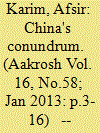

|
|
|
| 15 |
ID:
127336
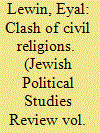

|
|
|
|
|
| Publication |
2013.
|
| Summary/Abstract |
Almost thirty-five years after Camp David and twenty years after the Oslo Accord, a fundamental question remains unanswered: does the majority of the Israeli public support a left-wing or right-wing ideology? The answer, in a democratic system, should be obvious, since elections are supposed to give a clear picture of the political preferences of the voting public. However, Israeli polls are misleading. After the Yom Kippur disaster in 1977, Menachem Begin won his premiership running as the hawkish leader who never would surrender even one grain of sand from the Land of Israel. Yet after he personally gave up the entire Sinai Peninsula his party won an even greater majority in 1981.1 Yitzhak Rabin won his premiership in 1992 representing the hawkish section of the Labor party with declarations that he would never negotiate with the PLO;2 yet it seems that signing the Oslo Accords led him, rather, to the peak of his popularit.
|
|
|
|
|
|
|
|
|
|
|
|
|
|
|
|
| 16 |
ID:
122430
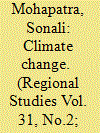

|
|
|
| 17 |
ID:
126802
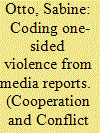

|
|
|
|
|
| Publication |
2013.
|
| Summary/Abstract |
Event datasets on political violence, which are comprised of coded collected news reports, have enjoyed a renaissance within the academic community. The inclusion of civilian fatalities within these datasets is a promising and welcomed advancement regarding the availability of data on one-sided violence. However, these datasets are often criticised due to their heavy reliance on media records, which may be tainted by biases. So far, little attention has been paid to the specific problems that arise in the coding procedure with respect to one-sided violence. This article addresses such difficulties by discussing particular challenges presented by media biases and by providing empirical evidence from coding one-sided violence. Furthermore, solutions and strategies are offered to the issues that could affect the coding process, including increased transparency, definition-adaptation, and the use of appropriate statistical models.
|
|
|
|
|
|
|
|
|
|
|
|
|
|
|
|
| 18 |
ID:
125360
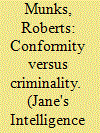

|
|
|
|
|
| Publication |
2013.
|
| Summary/Abstract |
The Colombian government and the insurgent FARC appear to be inching slowly towards a peace deal. Robert Munks assesses how the temptations of criminality and modalities of demobilization would be likely to act upon a post conflict FARC.
|
|
|
|
|
|
|
|
|
|
|
|
|
|
|
|
| 19 |
ID:
128979


|
|
|
|
|
| Publication |
2014.
|
| Summary/Abstract |
Civil conflict appears to be contagious-scholars have shown that civil wars in a state's neighborhood make citizens more likely to rebel at home. However, war occurs when both rebels and the state engage in conflict. How do state authorities respond to the potential for civil conflict to spread? We argue that elites will anticipate the incentive-altering effects of civil wars abroad and increase repression at home to preempt potential rebellion. Using a Bayesian hierarchical model and spatially weighted conflict measures, we find robust evidence that a state will engage in higher levels of human rights violations as civil war becomes more prevalent in its geographic proximity. We thus find evidence that states violate rights as a function of the internal politics of other states. Further, we argue authorities will act not to mimic their neighbors but rather to avoid their fate.
|
|
|
|
|
|
|
|
|
|
|
|
|
|
|
|
| 20 |
ID:
133698
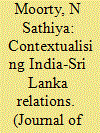

|
|
|
|
|
| Publication |
2014.
|
| Summary/Abstract |
Unlike what may have been reduced to in some circles, India- Sri Lanka relations are not a 'one-issue affair', centred on the vexatious ethnic problem in the island-nation, or on its influence and impact on
the south Indian State of Tamil Nadu. Instead, they continue to be multi-dimensional and multifarious, standing as testimony and test- case to the path of greater regional stability and cooperation, which
is in the interest of South Asia as a whole.
|
|
|
|
|
|
|
|
|
|
|
|
|
|
|
|
|
|
|
|
|